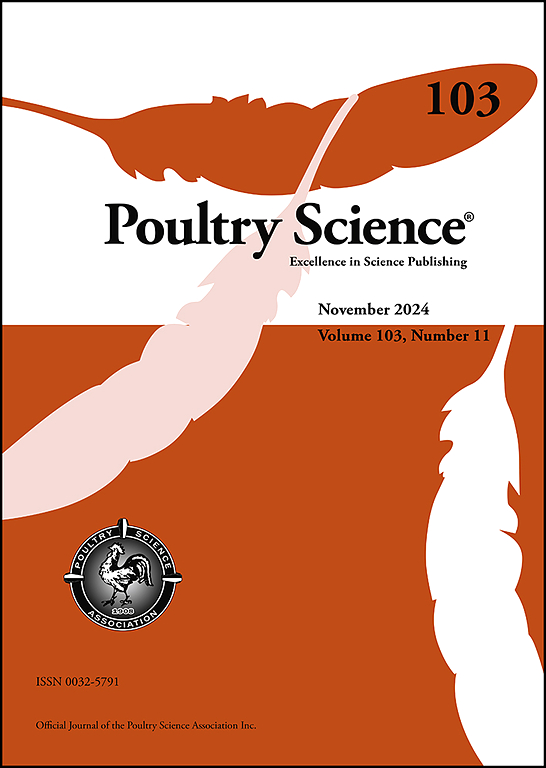2024年山东及邻省鹅圆环病毒鉴定及遗传进化分析
IF 4.2
1区 农林科学
Q1 AGRICULTURE, DAIRY & ANIMAL SCIENCE
引用次数: 0
摘要
鹅圆环病毒(GoCV)是一种影响水禽健康的重要病原体,给鹅业造成了重大经济损失。自1999年在德国首次发现以来,它已蔓延至全球。为了解GoCV在山东及邻近省份的流行情况、遗传特征和变异模式,本研究采用PCR方法对山东、河北、河南和安徽4省病鹅的GoCV阳性样本进行了筛选。选取10份阳性样本进行全基因组扩增和测序。结果表明,10株GoCV病毒全基因组、Rep基因和Cap基因的核苷酸序列同源性分别在96.9 ~ 99.5%、96.6 ~ 99.7%和96.8 ~ 99.3%之间;氨基酸序列同源性分别为94.4 ~ 99.3%、99.3 ~ 100%和98.0 ~ 100%。10株GoCV分离株与安徽、山东、河南、浙江4省的参考株同源性较高,与黑龙江、广东的参考株同源性较低,与3株鸭圆环病毒(DuCV)参考株同源性较低。遗传进化树分析显示,9个GoCV聚集在GoCV-Ⅰa分支内,1个GoCV-Ⅰb分支内。值得注意的是,这些分支与三种DuCV的分支明显不同,表明GoCV和DuCV之间存在遥远的系统发育关系。氨基酸序列分析结果显示,与中国大陆首株GoCV分离株AY633653.1 yk1相比,Rep和Cap蛋白在4、5、47、71和8、26、49、59、61、74、76、78、176、186个氨基酸位点发生突变。三维结构预测分析结果表明,这些蛋白在整体构型上具有较高的相似性,但在某些局部区域存在一定的差异。数据表明,GoCV在山东及其邻近省份的部分地区存在。Rep蛋白表现出高度的保守性,而Cap蛋白表现出高突变率。局部结构差异可能影响病毒的毒力和免疫逃逸能力;最后,GoCV在基因上与DuCV不同。持续监测和分析病毒突变趋势至关重要,因为它们在鹅圆环病毒病的早期预防和控制中起着关键作用。本文章由计算机程序翻译,如有差异,请以英文原文为准。
Identification and genetic evolutionary analysis of goose circovirus in Shandong and neighboring provinces in China in 2024
Goose circovirus (GoCV), a significant pathogen impacting waterfowl health, has led to significant economic losses in the goose industry. Since it was first identified in Germany in 1999, it has spread globally. To investigate the prevalence, genetic characteristics, and variation patterns of GoCV in Shandong and its neighboring provinces in China, this study used PCR to screen GoCV-positive samples collected from diseased geese in Shandong, Hebei, Henan, and Anhui provinces. Ten positive samples were selected for whole-genome amplification and sequencing. The results revealed that the nucleotide sequence homologies of the entire genome, the Rep gene, and the Cap gene of the 10 GoCV strains varied in the ranges of 96.9–99.5%, 96.6–99.7%, and 96.8–99.3%, respectively; furthermore, the amino acid sequence homologies were observed to fall in the ranges of 94.4–99.3%, 99.3–100%, and 98.0–100%, respectively. The 10 GoCV isolates showed high homology with reference strains from Anhui, Shandong, Henan, and Zhejiang provinces, relatively low homology with reference strains from Heilongjiang and Guangdong, and low homology with three duck circovirus (DuCV) reference strains. The genetic evolution tree analysis showed that nine GoCVs were clustered within the GoCV-Ⅰa branch, while one was classified into the GoCV-Ⅰb branch. Notably, these branches were clearly distinct from those of the three DuCVs, indicating a distant phylogenetic relationship between GoCV and DuCV. The results of the amino acid sequence analysis showed that compared with the first GoCV isolate from the Chinese mainland, AY633653.1 yk1, the Rep and Cap proteins had mutations at the amino acid sites 4, 5, 47, 71 and 8, 26, 49, 59, 61, 74, 76, 78, 176, 186, respectively. The results of the three-dimensional structure prediction analysis showed that these proteins had high similarity in their overall configuration, but there were certain differences in some local regions. The data indicate that GoCV is present in parts of Shandong and its neighboring provinces. The Rep protein exhibits a high degree of conservatism, whereas the Cap protein demonstrates a high mutation rate. Local structural differences may influence viral virulence and immune escape capability; finally, GoCV is genetically distinct from DuCV. Continual monitoring and analysis of mutation trends in the virus are essential, as they play a critical role in the early prevention and control of goose circovirus disease.
求助全文
通过发布文献求助,成功后即可免费获取论文全文。
去求助
来源期刊

Poultry Science
农林科学-奶制品与动物科学
CiteScore
7.60
自引率
15.90%
发文量
0
审稿时长
94 days
期刊介绍:
First self-published in 1921, Poultry Science is an internationally renowned monthly journal, known as the authoritative source for a broad range of poultry information and high-caliber research. The journal plays a pivotal role in the dissemination of preeminent poultry-related knowledge across all disciplines. As of January 2020, Poultry Science will become an Open Access journal with no subscription charges, meaning authors who publish here can make their research immediately, permanently, and freely accessible worldwide while retaining copyright to their work. Papers submitted for publication after October 1, 2019 will be published as Open Access papers.
An international journal, Poultry Science publishes original papers, research notes, symposium papers, and reviews of basic science as applied to poultry. This authoritative source of poultry information is consistently ranked by ISI Impact Factor as one of the top 10 agriculture, dairy and animal science journals to deliver high-caliber research. Currently it is the highest-ranked (by Impact Factor and Eigenfactor) journal dedicated to publishing poultry research. Subject areas include breeding, genetics, education, production, management, environment, health, behavior, welfare, immunology, molecular biology, metabolism, nutrition, physiology, reproduction, processing, and products.
 求助内容:
求助内容: 应助结果提醒方式:
应助结果提醒方式:


